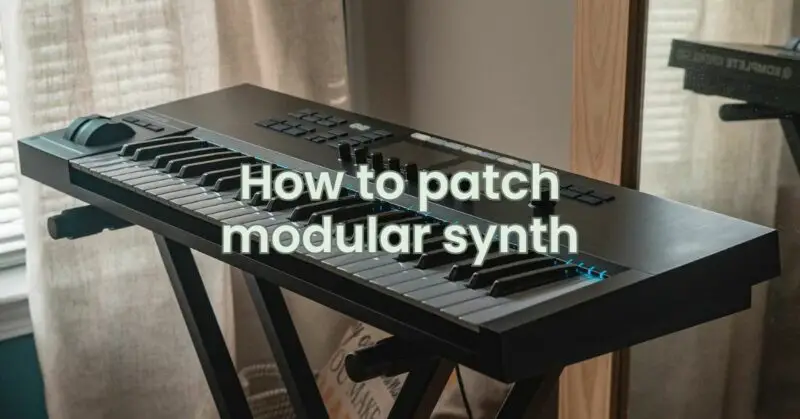Patch cables in hand, a modular synthesizer presents a realm of endless sonic possibilities and creative exploration. This unique electronic instrument allows you to sculpt and shape sound by interconnecting individual modules in captivating ways. However, approaching a modular synthesizer for the first time can be both exhilarating and daunting. In this article, we will guide you through the process of patching a modular synthesizer, providing the foundational knowledge to unlock the magic of this remarkable instrument.
Understanding the Basics:
Before diving into patching, familiarize yourself with the essential components of a modular synthesizer:
- Modules: A modular synthesizer consists of individual modules, each with its specific function. Common modules include oscillators (sound sources), filters (tone shapers), envelopes (amplitude controllers), LFOs (low-frequency oscillators), and more.
- Patch Cables: Patch cables are the connectors that establish signal paths between modules. They carry audio, control voltage (CV), and modulation signals, allowing you to shape sound by directing the flow of electricity.
- Input and Output Jacks: Modules have input and output jacks where you plug in patch cables. Inputs receive signals, while outputs send signals to other modules.
Getting Started:
- Set Up Your Synthesizer: Make sure your modular synthesizer is powered on and all modules are securely connected. You’ll need an assortment of patch cables in various lengths to get started.
- Start Simple: As a beginner, begin with a straightforward approach to avoid feeling overwhelmed. Focus on understanding the basic modules, such as oscillators, filters, and envelopes.
Patch Cable Color Coding (Optional):
Some musicians use color-coded patch cables to differentiate signal types:
- Audio Signals: Use one color (e.g., black or red) for audio signals, which carry sound from an oscillator to a filter or other sound-shaping modules.
- Control Voltage (CV) Signals: Use a different color (e.g., yellow or green) for CV signals that control parameters like pitch, filter cutoff, and modulation depth.
- Modulation Signals: Use another color (e.g., blue or white) for modulation signals, such as LFO outputs that influence other modules’ parameters.
Patching Techniques:
- Signal Flow: Start by understanding the signal flow of a sound-generating module. Connect an oscillator’s output to a mixer or filter’s input to hear the sound.
- Pitch Control: Patch a sequencer or keyboard’s CV output to the oscillator’s pitch input. Adjust the sequencer or keyboard to change the pitch of the sound.
- Filter Control: Experiment with filtering the sound by connecting an envelope generator’s CV output to the filter’s cutoff frequency input. This creates dynamic changes to the sound over time.
- Modulation Routing: Introduce modulation by patching an LFO’s output to the filter’s cutoff frequency input. Observe how the LFO rhythmically affects the filter’s sound.
- Exploring LFO Modulation: Further explore LFO modulation by patching the LFO output to the oscillator’s pitch input. Witness the oscillator’s pitch gently rise and fall with the LFO’s rhythm.
Experiment and Explore:
As you become more comfortable with basic patching, experiment freely and explore the endless possibilities. Combine multiple modules in novel ways, and don’t hesitate to try unconventional signal routings. The beauty of a modular synthesizer lies in its ability to surprise and inspire you with each patch.
Conclusion:
Patching a modular synthesizer is a journey of sonic alchemy, where creativity knows no bounds. By understanding the basic modules, learning to connect them with patch cables, and experimenting with various signal routings, you can unlock the full potential of this captivating instrument. Embrace the process of exploration, and let your imagination soar as you sculpt and shape soundscapes that are uniquely your own. With each patch, you’ll find yourself on an exhilarating path of sonic discovery and artistic expression, as the modular synthesizer becomes a conduit for your musical dreams.


